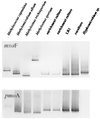High-affinity methane oxidation by a soil enrichment culture containing a type II methanotroph
- PMID: 10049856
- PMCID: PMC91137
- DOI: 10.1128/AEM.65.3.1009-1014.1999
High-affinity methane oxidation by a soil enrichment culture containing a type II methanotroph
Abstract
Methanotrophic bacteria in an organic soil were enriched on gaseous mixing ratios of <275 parts per million of volume (ppmv) of methane (CH4). After 4 years of growth and periodic dilution (>10(20) times the initial soil inoculum), a mixed culture was obtained which displayed an apparent half-saturation constant [Km(app)] for CH4 of 56 to 186 nM (40 to 132 ppmv). This value was the same as that measured in the soil itself and about 1 order of magnitude lower than reported values for pure cultures of methane oxidizers. However, the Km(app) increased when the culture was transferred to higher mixing ratios of CH4 (1,000 ppmv, or 1%). Denaturing gradient gel electrophoresis of the enrichment grown on <275 ppmv of CH4 revealed a single gene product of pmoA, which codes for a subunit of particulate methane monooxygenase. This suggested that only one methanotroph species was present. This organism was isolated from a sample of the enrichment culture grown on 1% CH4 and phylogenetically positioned based on its 16S rRNA, pmoA, and mxaF gene sequences as a type II strain of the Methylocystis/Methylosinus group. A coculture of this strain with a Variovorax sp., when grown on <275 ppmv of CH4, had a Km(app) (129 to 188 nM) similar to that of the initial enrichment culture. The data suggest that the affinity of methanotrophic bacteria for CH4 varies with growth conditions and that the oxidation of atmospheric CH4 observed in this soil is carried out by type II methanotrophic bacteria which are similar to characterized species.
Figures







References
-
- Bender M, Conrad R. Kinetics of CH4 oxidation in oxic soils exposed to ambient air or high CH4 mixing ratios. FEMS Microbiol Ecol. 1992;101:261–270.
-
- Bender M, Conrad R. Effect of CH4 concentrations and soil conditions on the induction of CH4 oxidation activity. Soil Biol Biochem. 1995;27:1517–1527.
-
- Benstead J, King G M. Response of methanotrophic activity in forest soil to methane availability. FEMS Microbiol Ecol. 1997;23:333–340.
-
- Carlsen H N, Joergensen L, Degn H. Inhibition by ammonia of methane utilization in Methylococcus capsulatus (Bath) Appl Microbiol Biotechnol. 1991;35:124–127.
Publication types
MeSH terms
Substances
Associated data
- Actions
- Actions
- Actions
- Actions
LinkOut - more resources
Full Text Sources
Molecular Biology Databases

